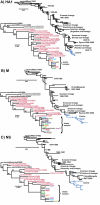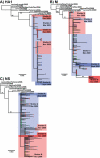Microevolution of canine influenza virus in shelters and its molecular epidemiology in the United States
- PMID: 20943966
- PMCID: PMC3004329
- DOI: 10.1128/JVI.01350-10
Microevolution of canine influenza virus in shelters and its molecular epidemiology in the United States
Abstract
Canine influenza virus (CIV) emerged around 2000 when an equine influenza virus (EIV) was transmitted to dogs in Florida. After 2003, the canine virus was carried by infected greyhounds to various parts of the United States and then became established in several large animal shelters, where it has continued to circulate. To better understand the evolution of CIV since its emergence, and particularly its microevolution in spatially restricted populations, we examined multiple gene segments of CIV from dogs resident in two large animal shelters in New York City during the period 2006 to 2009. In particular, we focused on viruses circulating in the two shelters in 2008 and 2009, which we found shared a common ancestor. While viruses in each shelter were generally monophyletic, we observed some gene flow between them. These shelter sequences were compared to earlier CIV isolates. The shelter viruses differed in 1 to 6 amino acids in each gene segment compared to viruses isolated in Florida between 2003 and 2005 and in Colorado in 2006 and 2008. A comparison of the sequences of equine and canine viruses revealed amino acid replacements that distinguished the viruses from the two hosts, but no clear evidence of positive selection indicative of host adaptation was detected, suggesting that any host range adaptation in CIV occurred early in the emergence of this virus or even before it transferred to dogs.
Figures


References
-
- Aaskov, J., K. Buzacott, H. M. Thu, K. Lowry, and E. C. Holmes. 2006. Long-term transmission of defective RNA viruses in humans and Aedes mosquitoes. Science 311:236-238. - PubMed
-
- Anonymous. 2008. Summary of the Australian equine influenza outbreak. Vet. Rec. 163:378. - PubMed
-
- Bauch, C. T., J. O. Lloyd-Smith, M. P. Coffee, and A. P. Galvani. 2005. Dynamically modeling SARS and other newly emerging respiratory illnesses: past, present, and future. Epidemiology 16:791-801. - PubMed
-
- Bryant, N. A., A. S. Rash, C. A. Russell, J. Ross, A. Cooke, S. Bowman, S. MacRae, N. S. Lewis, R. Paillot, R. Zanoni, H. Meier, L. A. Griffiths, J. M. Daly, A. Tiwari, T. M. Chambers, J. R. Newton, and D. M. Elton. 2009. Antigenic and genetic variations in European and North American equine influenza virus strains (H3N8) isolated from 2006 to 2007. Vet. Microbiol. 138:41-52. - PubMed
Publication types
MeSH terms
Substances
Grants and funding
LinkOut - more resources
Full Text Sources
Other Literature Sources

